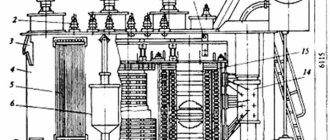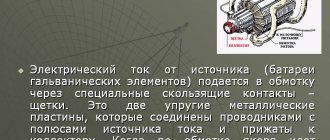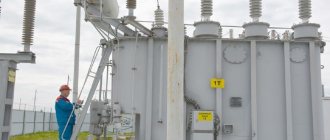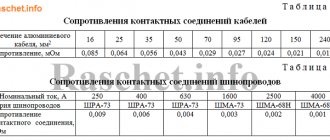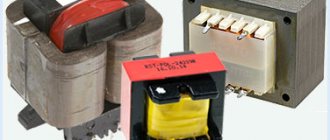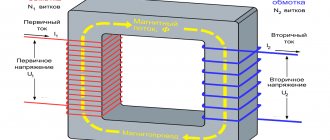UNBALANCE CURRENTS IN DIFFERENTIAL PROTECTION
TRANSFORMERS AND AUTOTRANSFORMERS
A) Components of unbalance current
With external short circuits and the load cannot provide a complete balance of secondary currents entering the relay. Due to the inequality of secondary currents in the relay in the indicated modes, an unbalance current appears, which can cause incorrect operation of the protection.
The inequality of secondary currents is determined by: the error of the current transformers; changing the transformation ratio of the power transformer when regulating voltage; incomplete compensation of inequality of secondary currents in the protection arms; the presence of magnetizing currents of the power transformer, introducing distortion into its transformation ratio.
Each of these reasons generates its own component I
nb. Let's consider these components and ways to estimate their values.
1) Component I
nb.t.t is caused by the presence of errors (magnetizing currents) of the current transformers supplying the protection (Fig. 16-19). Taking into account the magnetizing currents, the difference in secondary currents passing through the relay during an external short circuit,
Assuming that the inequality of primary currents in magnitude and phase is completely compensated, we obtain that I 1 / nI = I
II/
n
II
.
Taking this into account, from (16-17a) it follows that a current appears in the relay:
Expression (16-176) shows that, as in differential protection of lines and generators, the unbalance current caused by the error of the current transformers is equal to the geometric difference of the magnetizing currents of the protection current transformers.
This component of the unbalance current has the largest value and is the main one.
2) Component I
nb.reg appears when changing (regulating) the transformation ratio
N
of a power transformer or autotransformer.
Compensation for the inequality of primary currents, carried out using a compensating transformer or an auxiliary autotransformer, is provided at certain ratios of the currents of the windings of power transformers, determined by their transformation ratio N.
When N changes,
current compensation
nb.reg
Typically, the parameters of compensating devices ( w
yor
pa)
are selected for the average value N.
When
%
, an unbalance current appears
where I
rms - through short-circuit current flowing through the transformer.
Typically, power transformers and autotransformers are provided with taps that allow N
within ±5% of the nominal (average) value.
For transformers with N regulation
under
=
±10 ÷ 15%.
3) The unbalance component arising from inaccurate compensation of the inequality of arm currents I
nb.comp, appears in cases where the regulatory capabilities of compensating devices do not allow selecting the design values (
w
y or
pa)
necessary for full compensation.
4) Component due to the presence of magnetizing current I
us at the power transformer.
The magnetizing current violates the calculated relationship between the primary and secondary currents of the power transformer, which follows from the diagram in Fig. 16-23, and causes current I
nb.us =
I
us of the transformer.
In normal mode I
us power transformer does not exceed 1-5% of the rated current;
at short circuit the magnetizing current decreases; in transient conditions associated with a sudden increase in voltage on the transformer, the magnetizing current of the power transformer increases sharply. In load and short-circuit mode I
nb.us is usually not taken into account due to its small value.
5) Compensating transformers and autotransformers introduce an error in the transformation of arm currents, which causes the appearance of unbalance. However, this imbalance is very small and is therefore not taken into account.
From the above it follows that the total unbalance current in the differential protection of transformers with external short circuits. is determined mainly by I
nb.t.t and
I
nb.reg.
In some cases, current I is added to them
nb.comp,
caused by the inaccuracy of compensation for the inequality of tops in the defense shoulders.
Thus,
in the general case, the total unbalance current
b) Reasons for increased I
NB in differential protection of transformers and autotransformers
The magnitude of the unbalance current in the differential protection of transformers is usually greater than in the differential protection of generators, which is explained by the presence of additional components in the unbalance current ( I
nb.regi
I
nb.comp) and the large absolute value of the component
I
nb.t.t, due to the errors of the current transformers. The latter is caused by three features characteristic of differential protection of transformers.
The first of them is the design diversity of current transformers used on the high, medium and low voltage side of power transformers.
These design differences give rise to differences in the magnetic characteristics of current transformers and their magnetizing currents, which leads to an increase in the difference I
IInam -
I 1
us, which determines the value of
I
nb.t.t.
The characteristics of current transformers built into the bushings of oil circuit breakers (voltage 35 kV and above) differ especially sharply from the characteristics of remote current transformers used for voltages of 10 and 6 kV.
The second feature of differential protection of transformers is the high resistance of the load connected to the secondary windings of the current transformers,
and a significant difference in shoulder resistance.
The load resistance consists of the resistance of the connecting wires between the current transformer and the relay and is determined by the distance from the control panel where the relays are installed to the switchgears in which the current transformers protecting the power transformers are located. Very often these distances are significant and unequal in size.
In addition, it must be taken into account that the resistance of the linear wires puts a triple load on the current transformers connected in a triangle, due to which, even if the lengths of the arms are equal, the current transformers connected in a triangle are more loaded than the second group of current transformers connected in a star ( see § 3-7).
The third feature occurs in three-winding transformers, as well as in two-winding transformers with two switches on the side of any winding.
In these cases, the current multiplicity during external short circuits. for different groups of differential protection current transformers are different. After one group (T III)
the total short-circuit current flows, while only a part of this current flows through two groups
(T1
and
T II)
(Fig. 16-24).
As a result, the first group of current transformers T III
magnetized more strongly, which causes a sharp increase in their magnetizing currents compared to the magnetizing currents of the other two groups.
c) Calculation I
nb
Calculated unbalance current I
nb.t.t is estimated, just as in the differential protection of generators, using an approximate formula, based on the assumption that at the maximum value of the external short-circuit current.
Ik.max
error of current transformers ε does not exceed 10% (0.1). According to this
where k
one takes into account the difference in the error of the current transformers forming a differential circuit,
k
one = 0.5 ÷ 1;
with a significant difference in operating conditions and designs of current transformers, the difference in their errors reaches a maximum value and then k
one is taken equal to 1.
Taking into account expressions (16-18) and (16-20), the calculated value of the total unbalance current according to expression (16-19) will take the form:
d) Measures to prevent the action of protection against unbalanced currents
Preventing the operation of protection against unbalance currents is achieved by selecting the protection current I
Wed >
I
nb.
Obviously, this condition limits the sensitivity of the protection.
To ensure sufficient sensitivity of protection, measures are taken to reduce the value of I
nb.
Reducing unbalance currents
caused by the error of current transformers
I
nb.t.t
is ensured by selecting current transformers and their secondary loads in such a way that they do not saturate at the maximum value of the through-short-circuit current.
To ensure this condition, the current transformers and their secondary load are selected according to the maximum factor curves or according to the magnetization characteristics of the current transformers so that the error of the current transformers does not exceed 10%.
Although these measures make it possible to reduce the unbalance current (by reducing I
nb.t.t), its value remains large. In this regard, to increase the sensitivity of differential protection and at the same time for more reliable detuning from unbalance currents, relays connected through fast-saturating auxiliary transformers and relays with braking are used.
Topic 4.1: Checking and setting differential relays and power direction relays
Current differential relays
RNT-565, RNT-567, DZT-11 consist of a saturating current transformer and an actuator - the RT-40 relay.
Electromagnetic current relays with fast-saturating current transformers (BCT) are designed to provide differential protection of generators, electric motors, transformers and busbars.
A fast-saturating transformer operates like a regular transformer if an alternating current of normal frequency with a symmetrical waveform passes through its primary winding, i.e. current, each period of which consists of positive and negative half-cycles. In this case (Fig. 5.30 a)
the magnetic flux and the magnetic induction proportional to it in the BNT core changes from a positive
(B'max)
to a negative
(B'max)
maximum value, creating a large emf. on the secondary winding and there is sufficient current for the relay to operate.
The BNT works differently if a current with an asymmetrical curve shape passes through its primary winding, i.e. a current in which each period consists of only positive or only negative half-cycles, or of positive half-cycles with large amplitude and negative half-cycles with small amplitude (or vice versa). In this case (Fig. 4.30 b)
the magnetic flux and magnetic induction in the BNT core will change only from the positive maximum value
B
max to the value
Ba.
Therefore, a small emf will be created on the secondary winding, under the influence of which a current that is insufficient for its operation passes through the relay. This property of BNT is used to distinguish short-circuit currents. from the magnetizing current of the power transformer or unbalance current.
Short-circuit currents have an asymmetrical shape only at the first moment of time and after several periods they become symmetrical, as shown in Fig. 5.30 a.m.
Therefore, they are well transformed through the BNT and drive the relay.
The magnetizing currents of power transformers when they are energized have an asymmetrical curve shape, as shown in Fig. 5.30 b,
and therefore are poorly transformed through the BNT and do not activate the relay.
Unbalance currents reach large values in the first short-circuit periods, when they, as a rule, have an asymmetrical shape and therefore are transformed through the BNT as poorly as magnetizing currents.
Thus, from what has been considered it follows that when current relays are switched on through the BNT, they become insensitive to the magnetizing currents of power transformers and unbalance currents, which makes it possible to increase the sensitivity of the protection. At the same time, relays with BNT operate reliably during a short circuit. in the protection zone.
When setting up differential relays of the RNT series, it is necessary to remember that operating the relay with an open short-circuited winding is not recommended, as this leads to a change in the operating MMF and a deterioration in the detuning from aperiodic current surges. It is also not recommended to change the relay operating current by changing the position of the pointer on the scale or changing the angle of twist of the spiral spring. If the number of turns of the working winding is less than the calculated one, then a series connection of the working and equalizing windings is allowed (for the RNT-565 relay). The estimated number of turns is determined as the sum of the turns included on both windings. When calculating, the number of turns of the differential winding is rounded down to the nearest whole number.
The resistance value in the short-circuited winding circuit is set along with the settings. If it is not available, you can use the following indicative data:
— protection of generators and electric motors — 10 Ohm;
— busbar protection — 10 Ohm;
— protection of powerful transformers (autotransformers) — 3-4 Ohms;
— protection of power plant auxiliary transformers — 1.5-3 Ohm.
All relay tests are carried out directly on the protection panel from those panel terminals to which the cable cores from the corresponding current transformers are supplied.
Checking the executive body. The calibration of the executive relay is checked by applying a sinusoidal current to its winding according to the diagram in Fig. 5.31.
The relay should operate at a current of 0.16-0.17 A and a voltage of 3.5-3.6 V. If the operating parameters differ from the specified values, the actuator must be calibrated. To do this, the relay pointer is moved to the right until it fails and at a current of 0.16-0.17 A the relative position of the armature and the magnetic circuit is fixed, at which the voltage on the relay windings becomes 3.5-3.6 V.
Adjustment is carried out by moving the magnetic core; correction within small limits is carried out using the left stop screw. By placing the pointer in the operating position (against the mark) and changing the spring tension, we achieve a relay operating current of 0.16-0.17 A. The actuation voltage is re-measured, which should not go beyond 3.5-3.6 V. When adjusting operating current, make sure that if the spring is weakened, the armature touches the left stop. The return coefficient is checked, which should not be lower than 0.8. The return coefficient is adjusted by the final position of the armature under the poles (right thrust screw) and by changing the pressure of the contact springs.
The voltage on the relay coil is measured with a voltmeter with RBH
not less than 2000 Ohm, current - with an ammeter of type E513/4 or E525.
Checking MMF and primary operating current. The magnetomotive force of operation is checked for each protection arm at maximum turns on all used windings. The short-circuited winding is set to the specified resistance value Rk. The check is carried out according to the diagram in Fig. 5.31 b
or from a U5052 type installation. To avoid distortion of the shape of the current curve, the power for the rheostat circuit is taken from the linear voltage, and on the load block K514 of the U5052 installation, the pre-connected resistance is set to the highest possible value for the permissible current (200, 70 or 20 Ohms). The magnetomotive force of operation, equal to the product of the current in the protection arm and the total set turns in this arm, should be 100 ± 5 A. Adjustment is carried out by changing the value of Rsh. Adjusting the MMF response by changing the calibration of the actuator is unacceptable.
After the calculated turns are set, the operation and return current is checked for each protection arm. The relay return coefficient for the primary current may differ from the actuator return coefficient in one direction or another, since it depends on the ratio between the shunt resistance RШ
and total resistance Z of the executive body.
The operation of the relay contacts is checked by feeding one of the working windings with a current of 1.05 ICP
up to the maximum possible
short-circuit current.
Checking the correct execution of short-circuited windings. The tripping current is measured in one of the protection arms when the winding is open. The operating current should decrease by 20-30%. If there is any doubt about the correctness of the windings, the current in the circuit is measured with an ammeter connected to the gap of pin 9
relay (relay terminal designations are indicated in accordance with the factory documentation).
With a primary current corresponding to Fcр =
100 A, the absence of current in the windings will indicate their incorrect inclusion.
Checking the reliability coefficient. The reliability factor is determined by the current in the actuator without violating its setting. To do this, instead of a jumper 11-12 V
The relay circuit is switched on by an ammeter of type E525 at a measurement limit of 0.5 A. The relay armature is jammed in the dropped position.
The primary winding is supplied with a current corresponding to the primary MMF equal to Fcр, 2Fcp
and
5Fcр.
The ratio of the executive relay currents at
2Fcр
and
5Fcр
to the current at
Fcр
will be the reliability coefficient for a given multiplicity:
Deviations of the reliability coefficient in the direction of its reduction can be explained by the discrepancy between the parameters of the magnetic circuit and the technical specifications. For these relays, it is possible to reduce the operating current of the RT-40 relay to 0.16 A, while leaving the operating MMF equal to 100 A. If in this case the reliability factor is below the norm, then the relay is rejected.
Unlike RNT, relays of the DZT series do not have a short-circuited winding, which somewhat worsens the detuning from unbalance currents in the presence of an aperiodic component. Checking the executive body is carried out similarly to the RNT series relays.
Checking the absence of mutual induction between the brake and secondary windings of the intermediate transformers of the DZT-11 relay is carried out when applying m.f.s. to the brake winding. braking, which will take place at the operating setting and maximum short-circuit current. outside the differential protection zone of the corresponding side of the protected transformer. Measure the voltage on the open secondary winding of the DZT relay. At m.d.s. brake winding equal to 150 A, the voltage on the secondary winding should not be more than 0.1 V.
Checking the control points of the braking characteristics of the DZT-11 relay is carried out by supplying a sinusoidal current from a source with an adjusting rheostat to the working winding and current from another similar source to the braking winding. To change the phase difference, the brake winding is fed through a phase regulator or the windings are connected alternately to different linear and phase voltages of a three-phase alternating current network (Fig. 5.32).
With those indicated in the table. 5.2. values of working and braking m.f.s. the relay operates (control point “operation”) or does not operate (control point “braking”) for any phase difference (from 0 to 360°) between the operating and braking currents.
If m.m.s. operation differs from the values given in table. 7.5., by more than ± 10%, remove the braking characteristic of the relay to m.m.s. braking 800-1000 A.
Check the reliability of the relay contacts when the current changes from 1.05Iav
up to 5
Iav
.
Finally check the tightness of the screw connections. Install the turns of the windings in accordance with the settings. The relay is covered with a cover. The relay operation currents are measured at the operating settings on the side of each “arm” of protection. The operating, equalizing and braking windings of the relay are switched on according to the circuit in which they will be connected in the current transformer circuits.
For DZT relays, the operating currents are measured without braking and with braking turned on (the latter, if the braking characteristic allows the relay to operate at the given braking settings).
Checking braking performance. The maximum braking effect occurs when the phase shift angle between the currents in the braking and working windings is equal to zero or 180°. The resulting braking characteristic must be located below the upper limit characteristic guaranteed by the factory (Fig. 5.33).
Inductive power relay
reacts to the value and direction of power and has a closed magnetic system, two windings, one of which is connected to a current transformer and the other to a voltage transformer. Power direction relays are used in relay protection circuits to identify the line on which a short circuit has occurred.
Diagrams of the magnetic system and internal connections of the power direction relay of the RBM series are shown in Fig. 5.17 and fig. 5.18.
Each winding produces a magnetic flux, one of which is proportional to the circuit current, and the other to the circuit voltage, then the torque acting on the movable aluminum cylindrical rotor, in which eddy currents are induced, will be proportional to the power at the relay terminals, and its direction of rotation depends on the direction this power. The change in the direction of the current in the current winding of the power direction relay when the direction of the primary current changes is shown in Fig. 5.19.
Power direction relay type RBM-170, as shown in Fig. 5.17, consists of a closed steel magnetic circuit 1,
with four poles protruding inward on which the relay windings are located.
Current winding 2 is located on two opposite poles 8
and
4
and creates a magnetic flux FT passing through them
.
The voltage winding 5 is located on the yoke and consists of four sections, which are interconnected so that the magnetic flux they create is FN
passed through poles 6 and 7. Thus, the magnetic fluxes
FT
and
FN
are shifted in space relative to each other by an angle of 90°.
There is an internal steel core between the poles 8
and an aluminum rotor
9,
having the shape of a glass, mounted on an axis
10.
The polished ends of the axis
11
rotate in the upper bearing
12
and the lower bearing
13.
On the axis
10,
14
is mounted which, when the relay is activated, closes the fixed contacts
15
and
16.
The relay returns to its original position under the influence of a counteracting spiral spring 17.
FT magnetic fluxes
and
the FN
with the currents induced by them in the walls of the rotor creates a torque on the rotor.
The rated voltage of the relay is 100 V. The return coefficient is not less than 0.6. The power consumption of the current circuit at rated current does not exceed 10 VA. Checking the power consumption of the current circuit is carried out by measuring the voltage drop across the current winding when passing a rated current of 5 or 1 A. Checking the power consumption of the voltage circuit is carried out by measuring the current in the voltage winding circuit when a rated voltage of 100 V is applied to it. Relay operation power (sensitivity) at rated current and power consumption of voltage circuits at rated voltage and frequency of 50 Hz must correspond to the data in table. 5.1.
The relay response time at 3 times the response power, at the angle of maximum sensitivity (see definition below) and the simultaneous switching on of current and voltage is no more than 0.04 s for relays RBM-171, RBM-271, RBM-177 and RBM-277 and no more than 0.05 s for relays RBM-178 and RBM-278. The contact opening time when the current is reset to zero is equal to IN - 30IN,
and rated voltage or simultaneous shutdown of current and voltage, as well as when changing the direction of power does not exceed 0.05 s.
When removing reverse power, the duration of the closed state of the single-acting relay contacts due to the rejection of the moving system is no more than 0.04 s.
The relay current circuits can withstand currents up to 1.1IN
, and within 1 s -
30IN.
Relays RBM-178 and RBM-278 allow switching on at a voltage equal to the rated voltage for a period of 60 s; relays RBM-177, RBM-277, RBM-171 and RBM-271 can withstand a voltage of 1.1UH for a long time.
A change in the direction of currents in the windings of the power direction relay with the same direction of the primary current can be obtained by changing the circuit for connecting them to the current transformer (Fig. 5.20 a)
or to a voltage transformer (Fig. 5.20
b).
Instructions for checking DZT series relays with magnetic braking
Instructions for testing relays of the DZT series with magnetic braking Compiled by the technical information bureau ORGRES Authors: engineers B. I. Iofyev and N. F. Shibenko Editor: engineer M. M. Mirumyan Publisher: M.-L.: Energia, 1965
This instruction describes methods for testing domestically produced relays of types DZT-1, DZT-3, DZT-3/2 and DZT-4 with magnetic braking, used for differential protection of transformers and autotransformers. The instructions can be partially used when testing other types of magnetic braking relays. Relays of the DZT series with magnetic braking are used in differential protection of transformers and autotransformers in cases where detuning from unbalance currents during external short circuits leads to unacceptable hardening of the differential protection if performed with relays of the RNT series. The use of a relay, the operating current of which depends on the magnitude of the current flowing in the secondary circuits of differential protection, as a rule, makes it possible to ensure sufficient sensitivity of protection in the event of a short circuit in the area of its action, not only in normal, but also in the minimum operating modes of the transformer (autotransformer). This is achieved by the fact that at high short-circuit currents, the protection operation current due to braking automatically increases, thereby eliminating the possibility of protection from increased unbalance currents if the damage occurs outside the protection coverage area. If there is damage within the protection coverage area, the sensitivity of the protection due to braking is slightly reduced. The degree of detuning of protection against unbalance currents in case of external short circuits and the sensitivity of protection in case of faults in the zone are determined by the dependence of the operating current on the braking current of the relay selected when calculating the settings, i.e., the so-called braking characteristic of the relay. A relay with braking of the DZT series, like a relay without braking of the RNT series, carries out a magnetic comparison of currents in the arms of differential protection, their equalization by turning on the corresponding number of turns of the working windings determined by calculation, and detuning from surges of transformer magnetizing currents by turning on the executive relay through intermediate saturable transformers. A distinctive feature of the DZT relay is the presence of brake windings, which are connected to the currents of individual groups of differential protection current transformers and determine the dependence of the protection operation current on the current in its arms, i.e. braking. Relays of the DZT series differ in the number of circuits through which braking can be carried out, and the parameters of the windings. The use of one or another type of relay of this series is determined by the rated secondary currents of the current transformers from which the protection is powered (5 or 1 A), the type of protected transformer (two-winding, three-winding, etc.), the connection diagram of this transformer to other elements of the power system, the size short circuit currents passing through the transformer, etc.
Figure 1. Simplified differential protection diagram of a three-winding transformer with a DZT-3 type relay (for one phase) and the arrangement of windings on intermediate saturable transformers (branches on the windings are not indicated). Ɯд – differential operating winding; Ɯur – equalizing working winding; in fact, of the three windings available, one is shown; Ɯ21, Ɯ22, Ɯ23 – first, second and third secondary windings; Ɯт1, Ɯт2, Ɯт3 – first, second and third brake windings; NT1, NT2, NT3 – first, second and third saturable transformers; T – executive relay.
The DZT series relay consists of two main elements: intermediate saturable transformers on which the working, secondary and brake windings are located, and an executive relay - an electromagnetic maximum current relay of the ET-521 type, connected to the terminals of the secondary windings of the intermediate saturable transformers. Each intermediate saturable transformer consists of a stacked steel three-rod core, the middle rod of which is covered by working windings, and secondary and brake windings are located on the outer rods. In the relays currently produced by the plant, one, three or four intermediate saturable transformers are installed (the number after the designation of the relay series shows the number of intermediate saturable transformers present in the relay). The working windings are common to all saturable intermediate transformers present in the relay (they cover the middle rods of all saturable transformers of a given relay). Each intermediate transformer has one brake winding, which is connected to the corresponding protection arm. Each brake winding consists of two parts with the same number of turns, connected in such a way that the magnetic flux they create is closed only along the outer rods and, magnetizing them, does not fall into the middle rod covered by the working winding. The secondary windings of all intermediate saturable transformers are connected to each other in parallel and connected to the winding of the current relay. Each secondary winding consists of two parts with the same number of turns, connected in such a way that the e.g. induced into them by the working flow. d.s. were summed up, and the total e. d.s. from the magnetic fluxes of the brake windings was equal to zero. As an example, Figure 1 shows a simplified diagram of the differential protection of a three-winding transformer with a DZT-3 type relay (for one phase) and schematically shows the placement of windings on intermediate saturable transformers of the DZT-3 type relay. On intermediate saturable transformers of relay types DZT-1, DZT-3/2, DZT-4, the windings are placed similarly. To regulate the protection response currents and the degree of braking, as well as to equalize the secondary currents from the working and braking windings, branches are made. Switching of branches is carried out either by screwing a contact screw into the corresponding socket, or by switching a jumper into the corresponding terminals on the switching boards. Switching the turns simultaneously on both brake windings using one switch is done as follows. To measure the current in the winding of the executive left-right relay and to separate the core circuits of the operating and brake windings when checking the relay, special jumpers are provided between the relay terminals associated with the corresponding windings.
Figure 2. Switching diagram of the branches of the brake windings of the DZT series relay. a – using one jumper; b – using two jumpers.
The DZT-1 type relay has a working winding, consisting of one differential and two equalizing windings, and a brake winding. The long-term permissible current of the working and braking windings is 10 A. The power consumed by the relay in short-circuit mode outside the protection zone at a current of 5 A and fully switched on turns of the braking and working windings does not exceed 7 VA (in the absence of current imbalance). The DZT-3 type relay has a working winding, consisting of a differential and three equalizing windings, and three brake windings. The long-term permissible current of the working and braking windings is 10 A. The power consumed by the relay in short-circuit mode outside the protection zone at a current of 5 A and fully switched on turns of the braking and working windings does not exceed 10 VA (in the absence of current imbalance). The power consumed by the relay in short circuit mode in the protection zone at a current of 5 A does not exceed 45 VA. The DZT-4 type relay has a working winding consisting of one differential and three equalizing windings, and four brake windings. The long-term permissible current of the working and braking windings is 10 A. The power consumed by the relay in short-circuit mode outside the protection zone at a current of 5 A and fully switched on turns of the braking and working windings does not exceed 10 VA (in the absence of current imbalance). The power consumed by the relay in short circuit mode in the protection zone at a current of 5 A does not exceed 45 VA. The DZT-3/2 type relay has three brake and three operating windings and is intended for those cases when the rated secondary current of two groups of current transformers is 1 A, and the third group is 5 A. The operating and brake windings in normal mode can withstand the current for a long time: a) the first windings (pins 1 - 7): all turns of the brake and working windings - 1.2 A, working winding - 0.7 A; b) second windings (pins 3 – 9): all turns of the brake and working windings - 3.5 A, working winding - 1.2 A; c) third windings (pins 5 – 11): all turns of the brake and working windings - 12 A. Power consumption in short circuit mode outside the protection zone with fully turned on turns of the working and brake windings does not exceed (in the absence of current imbalance): a) in the first working and braking windings at a current of 0.35 A - 3 VA; b) in the second working and braking windings at a current of 0.6 A - 3 VA; c) in the third working and braking windings at a current of 3.5 A - 6.5 VA. The power consumption in the event of a fault within the protection coverage area and five times the operating current at the minimum setting does not exceed 140 VA for the circuit of each working and corresponding brake windings.
Figure 3. Electrical connection diagram of the DZT-1 type relay and its connection diagram (in the transformer differential protection circuit (for one phase). Ɯд – differential operating winding; Ɯur1, Ɯur2 – first and second equalizing windings; Ɯ2 – secondary winding; Ɯт – brake winding; T – executive relay.
The principle of operation of a relay with braking can be most easily demonstrated using the example of a relay of the DZT-1 type (Figure 3), which has one intermediate saturable transformer with one brake, one differential and two equalizing windings (two equalizing windings allow the relay to be used to protect three-winding transformers). When current flows in the working winding of the intermediate saturable transformer in the middle rod (Figure 4), a working magnetic flux Frab is created. This magnetic flux branches out and, closing in the outer rods, induces electromotive forces in the secondary windings. The secondary windings are connected in such a way that the induced magnetic flux in the windings of the left and right rods is e. d.s. are summed up. Under the influence of the amount of e. d.s. a current is created in the coil of the executive relay T.
Figure 4. Schematic diagram of an intermediate saturable transformer of the DZT-1 relay. Frab – magnetic flux created by the working winding; Фт – magnetic flux created by the brake windings Фт; Ɯр – working winding; Ɯ2 – secondary windings.
When current flows in the brake winding, a braking magnetic flux Ft is created. As mentioned above, the brake windings are connected in such a way that the magnetic flux they create is closed along the outer rods and does not fall into the middle one. Induced by the braking flow in the secondary windings of e. d.s. are directed towards each other and cancel each other out, therefore, under the influence of the braking magnetic flux e. d.s. does not appear at the output of the secondary winding, which means that no current occurs in relay T. The braking magnetic flux only magnetizes the outer cores of the magnetic circuit, saturates them and thereby affects the amount of current in the secondary winding of the intermediate transformer.
Content
Chapter one General information about the relay of the DZT series with magnetic braking 1. Purpose and scope of application of the relay 2. Relay design 3. Principle of operation Chapter two Adjustment and testing of the relay 4. General instructions 5. External inspection and check of the mechanical part 6. Insulation check 7. Setting the executive relay 8. Checking the absence of mutual induction between the braking and secondary windings of intermediate transformers 9. Setting the relay operating currents when the executive relay is powered from intermediate transformers 10. Checking the reliability coefficients 11. Checking the braking characteristics 12. Checking the relay consumption 13. Determining the protection response time 14. Additional checks 15. Testing the relay with load current in a complete protection circuit Appendix 1. Technical data of the DZT series relay Appendix 2. Recommended scope of work for testing the DZT series relay Appendix 3. Protocol Appendix 4. Devices and instruments required when testing the relay Literature
